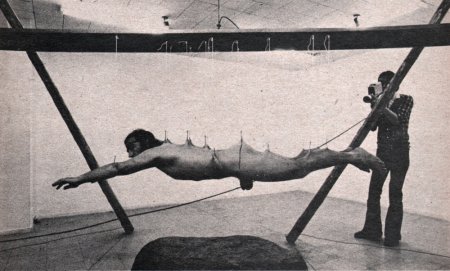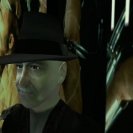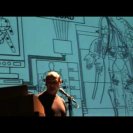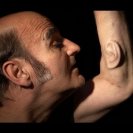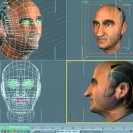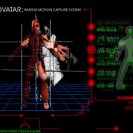Stelarc was born in 1946 in Cyprus and after emigrating to Melbourne studied at Caulfield College of Advanced Education and the Royal Melbourne College of Technology, Australia.1 He began with performance work, which he describes as “essentially multimedia events”2 and in which he was involved not as a performer rather more as choreographer/director. One early event was his From Micro to Macro and in Between performed at the Hamilton Gallery, Victoria, in December 1968, in which “three dancers, choreographed by the artist, performed in front of” computer graphics projected onto screens3 to musique concrète. The audience were offered “helmets and goggles that altered binocular vision,” distorting the viewer's perceptions of the event4 “by superimposing fragmented images from the rear and to the sides of the wearer.”5 As Marsh goes on to say, the early works “encouraged people to participate by giving them access to the performance equipment.”6
His immediately later works turned more to the use the technologies to enhance the visual spectacle. As Stelarc has said:
“I was more interested in the use of the body as a direct medium of expression - as opposed to painting and sculpture for instance, or the production of artifacts. I conceived of actions within a multimedia or multimodal approach, using sound, light, multiscreen images and so on.”
He was influenced by the Australian pioneer of electronic art, Stan Ostoja-Kotkowski, as well as international artists such as Alan Kaprow, Robert Rauschenberg and John Cage.
Around 1970 Stelarc moved to Japan and for a time worked as an English language teacher in Yokohama. While there he continued his performances and exploration of new technologies that he could use in them, meeting many Japanese contemporary artists while there. While there he began his suspension performances which in their early versions were performed with ropes and harnesses, but now using amplified body sounds and brain waves.7 He comments that:
“I wanted sounds that were intrinsic to the movement, and so gradually it occurred to me to use body signals. Remember too that in the late `60s there was a lot of interest in biofeedback mechanisms, so these things in combination focussed me on the idea of amplifying the body signals. It was a question of relating the various elements of the performance. Also, as the body became the focus of expression and experience, it was necessary to situate these elements within it.”8
Some of these performances took place in Australia and Stelarc maintained his contact with artists and curators here. He was instrumental in the inclusion of many of the Japanese artists in the 1976 Biennale of Sydney, directed by Tom McCullough.Although he was not able to come to Sydney for the Biennale himself, as he was working in Japan, Stelarc presented photographic and video documentation of his suspension performance, Event for Stretched Skin (1976). The videotaped performance was described by one critic as “disgustingly masochistic showing the artist being strung up by fishhooks.”9 Another critic describes it a little more dispassionately: “he appears hanging like a hairy marlin from some fishing hooks piercing his naked body. In spite of dripping blood , the result is coolly esthetic, as evidenced by the pre-meditated relationship of horizontal volumes beneath the suspended body and the rock placed underneath.”10 The suspensions were neither masochistic nor shamanism but performances of an indifferent body, a body simply understood as object: suspended with the intention of “extending intelligence beyond the earth.”11 This was the first of the suspensions that involved the fishhooks, but it lead to a series that continued in Japan and then were made in Europe, the United States and Australia.
- 1. Tom McCullough (director), Recent International Forms in Art, Biennale of Sydney, 1976, Sydney: Biennale of Sydney.
- 2. Rainer Linz, “An interview with Stelarc,” New Music Articles NMA#10, 2001. Available at http://www.rainerlinz.net/NMA/repr/Stelarc_interview.html
- 3. Ann Marsh, Body and Self: performance art in Australia, 1969-73, Melbourne: Oxford University Press “Australia, 1993, 25.
- 4. Rainer Linz, “An interview with Stelarc,”
- 5. Ann Marsh, Body and Self: performance art in Australia,
- 6. Ibid.
- 7. Rainer Linz, “An interview with Stelarc,”
- 8. Ibid. This interview contains a much deeper discussion of Stelarc's use of body sounds. I recommend it.
- 9. Sandra McGrath, “Sandbags, balloons and stuffed rabbits” Arts Australian: The Australian, Nov. 16, 1976.
- 10. Eneide Mignacca, “Hanging the Human Marlins” Nation Review, 2-6 Dec. 1976, 162.
- 11. Stelarc quoted in Brian Massumi, “The Evolutionary Alchemy of Reason: Suspended Animations”, in Stelarc (editor), Alternative Interfaces: Stelarc, Melbourne: Monash University, 2002, 25.
Stelarc video tapes, mostly documentation of performances. [To be developed.]
Event for Stretched Skin (1976) Performance, Recorded in Videotape and Photographs Dimensions: 400cm x 120cm Exhibited in 1976 Biennale of Sydney Exhibit kindly lent by the artist. Photographed by Shigeo Anzai.
The Third Hand, developed in Japan, made its Australian début in Melbourne in 1980
1988, AGNSW Stelarc, Amplified Body Third Hand (performance and multimedia installation) Tony Bond, assisted by Victoria Lynn
1969 "Events from Micro to Macro and in Between", Hamilton Art Gallery, Hamilton, Victoria. 1970 "Sound and Image Experience", The Open Stage, Melbourne. 1971 "Three Events", Squash Court, Yokohama, Japan.
1972 "Blink: Event for Tree and Amplified Man" Christchurch, Yokohama, Japan. 1972 "Blink: Event for Amplified Man, Tree and Balloon" sponsored by the German Cultural Centre Tokyo, Japan. 1972 "Room for Goggles, Helmets, Compartment and Brainwaves", Harumi, Tokyo, Japan. 1972 "Gulp: Event for Amplified Man, Tree and Lasers" sponsored by the Myer Foundation, Melbourne, Australia.
1973 "Blink: Star-Man/Star-Dust" sponsored by the Athenee Francais CulturalCentre, Tokyo, Japan. 1973 "Event for Rock, Amplified Man and Probing Eye" sponsored by the Athenee Francais Cultural Centre, Tokyo, Japan. 1973 "Event for Rock, Brainwaves and Tunnel", Tomioka Tunnel, Yokohama, Japan. 1973 "Event for Rocks/Brainwaves/Treel Stomach Probe/Lasers", Libre Gallery, Claremont, U.S.A. 1973 "Event for Utterances/ Brainwaves/Stomach", San Jose State University, U.S.A. 1973 “Attempted poetry reading on top . of "The Pyramid of the Moon", Teotihuacan, Mexico. 1974 "Event for Balloon/Planet/Comet", Asagiri Kogen, Shizuoka Prefecture, Japan. 1974 "Event for Comet/Planet/Probing Eye", Tamdra Gallery, Tokyo, Japan. 1974 Poetry reading, Daimarti, Kyoto, Japan. 1974 "Event for Anal Probe/Rocks/Laser/Eyes/Tree" sponsored by the German Cultural Centre, Tokyo, Japan. 1974 "Event for Insertions/ Extensions", sponsored by the German Cultural Centre, Tokyo, Japan. 1974 "Event for Intemal/External Probes", Casa del Lago, sponsored by U.N.A.M. Difusion Cultural, Mexico City. 1974, "Event for Internal/ External Probes", Museo Universitario, sponsored by U.N.A.M. Difusion Cultural, Mexico City, Mexico 1974 Poetry reading on top of "The Corridors", Tepoztlan, Mexico. 1975 "Mind Maps", March 10-16, Maki Gallery, Tokyo, Japan. 1975 "Event for Mind Loop/Lungs/Laser Eyes", June 13, German Cultural Centre, Tokyo, Japan. 1975, "Event for Amplified/Modified/Monitored Man", July 21 August 1, Ewing Gallery, Melbourne, Australia. 1976, "Event for Modified Man", January 26-February 1, Tamura Gallery, Tokyo. Japan.
1971, "Crosstalk", sponsored by the American Cultural Centre, Tokyo, Japan.
1974, "Studiokonzert Neuer Musik" sponsored by the German Cultural Centre, Tokyo, Japan.
1974, "The Letter Show", Ewing Gallery, Melbourne, Victoria, Australia.
1975, "Exhibism"20 Japanese Artists, June 6-12, Kanagawa Prefectural Gallery, Yokohama, Japan.
1975, 'Studio Fur Neue Music March 7, Statische Galerie, Munich, Germany.
1975, "Gesangsabend" December 17-Deutsch/Americanisches Institute, Regensberg, Germany.
1975; "Wordworks II” April, San Jose State University C.A., USA.
1975, "Music From our Times", October 5, Melbourne University Art Gallery, Melbourne, Australia.
1975, "Music from Our Times", October, Ngaio Marsh Theatre, Christchurch, New Zealand.
1976, "Pan-Conceptuals", January 5-18, Maki Gallery, Tokyo, Japan.
Other activities by the artist include
1973, Micro-films of the inside of the artist's stomach, Yaesu Cancer Research Center, Tokyo, Japan.
1975, 16mrn color film of the inside of the artist's lungs- 15 minutes, Hamamatsu Hospital, Hamamatsu, Japan.
1975, B & W video-tape/vertical X-Ray scan of the artist's body - 55 minutes, Yaesu Cancer Research Centre, Tokyo, Japan.
